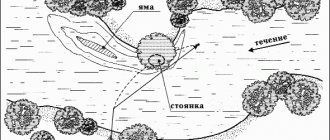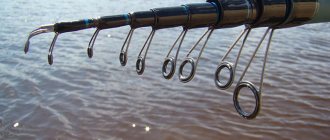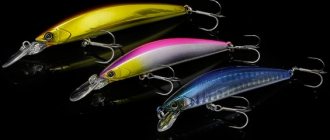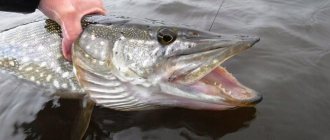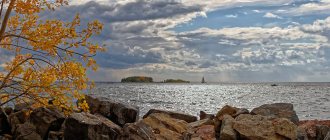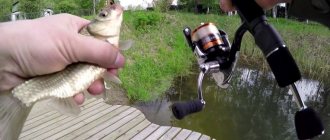Fishing Features
Getting to those areas where this fish is found in relatively large numbers can sometimes be difficult. Therefore, you have to fish where the population is small. Sometimes a fisherman covers more than one kilometer and fishes vast areas in order to catch just a couple of individuals. And yet, catching nelma is so exciting that no one is stopped by the distance that has to be overcome for the sake of catch, and no one is afraid of wild, difficult places. As a rule, experienced, well-trained fishermen go on such fishing, wearing special uniforms and all the necessary fishing equipment.
Where and what to catch
As already mentioned, fishing for nelma is possible only in the North of Russia, since this cold-loving fish is simply not available in other regions. Most often it can be found near rapids, in sections of the river with a reverse flow, and on rocky ridges. Spinningists call such places the most promising.
They use oscillating, rotating, and wobblers as bait for In recent years, a pinwheel consisting of a copper core and a silver petal has become popular.
Experienced fishermen recommend hunting nelma using fan fishing in a selected area. At the same time, it is more convenient to move from one riffle to another by boat. For obvious reasons, the boat should move downstream. This kind of fishing is too difficult for one person, so it’s better to fish with a group. On the first day, you can go down the river, landing one fisherman at each riffle. As a result of such reconnaissance, promising points will be identified where you can successfully fish the next day.
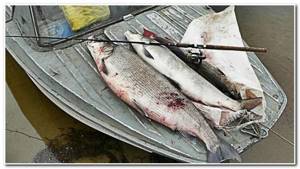
Nelma gather at the riffles when the flood ends and the water level drops to summer standards. If pebble ridges begin to be visible in the river, then it’s time to prepare your gear. There is one time-tested rule in fishing for nelma: the lower the water, the better it is caught. Only the weather can ruin this exciting activity. If the summer turns out to be rainy and the water level remains high, you should not count on an active bite.
Habitats
In a broad sense, these are the giant Siberian rivers: the Ob, Yenisei, Lena and their large tributaries, such as the Irtysh. The three listed above flow into the Arctic Ocean, where near the coasts and at the mouths of rivers flowing into narrow bays, the so-called. lips, and schools of nelma live. The ideal, from the point of view of this fish, is a mixture of salt and fresh water, or sea water of low salinity - no more than 20 ppm.
In late spring and early summer, depending on the onset of ice drift, adult (from 6 years old) nelma rush into fresh waters to spawn. They reach their spawning grounds in the middle and upper reaches of rivers, traveling about a thousand kilometers, spawn and return to the sea in the fall. Over the next year, the water current gradually carries the hatched fry there, although some may linger in fresh water for a year or two.
Fishing for nelma is carried out only in the river; it is not caught in the sea.
This is a Red Book species. However, there is no penalty for accidentally catching whitefish as bycatch when the hunt was for completely different prey.
In a narrow sense, habitats include sections of rivers where this fish likes to stay. Nelma approves only of clean running water, appreciates rapids and often the small quiet bays adjacent to them, where small white fish, its main prey, like to feed. Like any predator, you need to look for it where the prey may be:
- vendace;
- smelt;
- carp;
- perch;
- whitefish.
White salmon fry can pick up insects from the surface of the water. This fish generally tends to stay near the surface or at a shallow depth, up to two meters, because it is not an ambush, but a driven predator that requires space.
Nelma can feed near the riffles, where the water is bubbling, washing small fish out of hard-to-reach places, but not in the riffles themselves. You can also try to look for it near shallows with a pebble or sandy bottom, located not near the shore, but closer to the middle of the river.
Fishing for nelma on the Ob, for example, is most effective along the steep right bank. The left, Western Siberian coast is shallow water and floodplain, an unsuitable place for nelma. The same principle can be applied to the rest of the Siberian rivers flowing to the north.
The whitefish loves areas where rock spits abruptly drop into the depths, and there may be large washouts under the water. But, nevertheless, the fundamental principle for the silver predator is always preserved: a pebble or sandy bottom.
Tackle for catching nelma
Rod
Since nelma belongs to the salmon family, it is advisable to choose a special rod designed for salmon fishing. Americans classify it this way – for salmon. This powerful and flexible tool allows you to cast heavy baits far, perfectly holds resisting fish in fast currents, and at the same time it has sufficient sensitivity for good control of the spoon. Salmon spinning rods are produced by many American and Japanese companies, and in recent years such products have also appeared from some Korean manufacturers. At the same time, their fishing rods are in no way inferior to well-known brands in terms of quality and characteristics. An excellent choice would be Lamiglas Certified Pro, Daiwa Whisker or Norstream Dynamic rods with a test weight of 5 to 20 g.
Coil
The reel also has its own requirements. Firstly, it must be a reliable mechanism that can withstand serious loads during fishing. In addition, the spool must be voluminous (at least 3000) so that 120-150 meters of braid with a diameter of 0.14 mm can freely fit on it. The recommended gear ratio is 5 or 6:1. With these parameters you can find a reel in the middle price range. That is, it is not at all necessary to spend money on an expensive device, the price of which is inflated due to completely unnecessary elements such as an additional cover on the case. It covers the heads of the screws, but is itself screwed onto the same ones.
fishing line
Instead of a strong, and therefore thick fishing line, which floats a lot when casting, it is better to use a thinner braided cord with a smooth surface. Monofilament is unlikely to be able to withstand a critical load after the hooked fish enters under some obstacle located in the water, whereas with braid the chances of pulling it out are much higher. The color of the line in catching nelma is not particularly important; by and large, it is indifferent to it. This allows you to use bright cords, which make it easier to control the bait while retrieving.
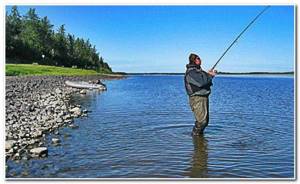
Catching baits for nelma
The best baits for catching nelma are spinners weighing 9-14 g, their color should be silver, close to the shade of the fish itself. Nelma are caught well with a Scale spinner; Mepps Aglia and Kastmaster spinners are also considered high quality. Many fishermen use Devons, fishing with narrow rotating baits. The baits are chosen medium so that the fish can grab them.
The following types of bait are also suitable for fishing:
- silver-colored oscillating spoons;
- streamers;
- wobblers.
When wondering how to catch nelma, it should be noted that you should buy medium-sized spoons, because the fish has a small mouth, and it always captures prey across the body. Baits and fastenings should be small but strong, the spoon should be attached to a leash. After connecting all the elements, make sure the entire structure is strong and only then start fishing.
The best time to catch nelma
Fishing for nelma continues almost until the freeze-up, and many anglers claim that large specimens are most often caught closer to winter. This is not surprising; the same can be said about many other species. To survive until spring, fish need to stock up on fat. Our target is no exception.

The best time for fishing nelma is morning and evening, and according to observations, it bites much more actively in the evening hours. At the designated time of day, the predator goes out to shallow ridges to feed on fry, which is always in abundance here. Not only small fish can become its victims. Nelma is a formidable inhabitant of the Siberian river, eating everything, from its own relatives (whitefish) to perches and pikes. It is at this moment, when she is busy excitedly getting food, that she needs to be caught.
The most effective fishing for nelma is observed in calm, windless weather. On quiet days it is interesting to watch its colorful exits to the surface. Unsuspecting schools of fry are swimming peacefully at the very top, when suddenly a dark back appears from the depths. The predator attacks them instantly, cutting the water with an oblique fin. Such a sight makes the fisherman’s heart skip a beat, and a few seconds later, when he manages to pull himself together, the spoon is already flying to the place where a huge fish sparkled with its silver side.
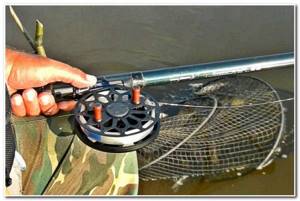
Habitats
In a broad sense, these are the giant Siberian rivers: the Ob, Yenisei, Lena and their large tributaries, such as the Irtysh. The three listed above flow into the Arctic Ocean, where near the coasts and at the mouths of rivers flowing into narrow bays, the so-called. lips, and schools of nelma live. The ideal, from the point of view of this fish, is a mixture of salt and fresh water, or sea water of low salinity - no more than 20 ppm.
In late spring and early summer, depending on the onset of ice drift, adult (from 6 years old) nelma rush into fresh waters to spawn. They reach their spawning grounds in the middle and upper reaches of rivers, traveling about a thousand kilometers, spawn and return to the sea in the fall. Over the next year, the water current gradually carries the hatched fry there, although some may linger in fresh water for a year or two.
Fishing for nelma is carried out only in the river; it is not caught in the sea.
This is a Red Book species. However, there is no penalty for accidentally catching whitefish as bycatch when the hunt was for completely different prey.
In a narrow sense, habitats include sections of rivers where this fish likes to stay. Nelma approves only of clean running water, appreciates rapids and often the small quiet bays adjacent to them, where small white fish, its main prey, like to feed. Like any predator, you need to look for it where the prey may be:
- vendace;
- smelt;
- carp;
- perch;
- whitefish.
White salmon fry can pick up insects from the surface of the water. This fish generally tends to stay near the surface or at a shallow depth, up to two meters, because it is not an ambush, but a driven predator that requires space.
Nelma can feed near the riffles, where the water is bubbling, washing small fish out of hard-to-reach places, but not in the riffles themselves. You can also try to look for it near shallows with a pebble or sandy bottom, located not near the shore, but closer to the middle of the river.
Fishing for nelma on the Ob, for example, is most effective along the steep right bank. The left, Western Siberian coast is shallow water and floodplain, an unsuitable place for nelma. The same principle can be applied to the rest of the Siberian rivers flowing to the north.
The whitefish loves areas where rock spits abruptly drop into the depths, and there may be large washouts under the water. But, nevertheless, the fundamental principle for the silver predator is always preserved: a pebble or sandy bottom.
Fishing tactics
It is advisable to stay at a distance equal to the length of the throw from the roll, and it is better to fish a promising area in zones, starting from the top. As soon as the bait falls into the water, it must immediately be set in motion. This is important, since nelma often reacts to a splash after the spoon comes into contact with water. Gradually the fishing moves downstream, but you shouldn’t move too far from the riffle. The fact is that pike often set up ambushes from the ridge, so there are no salmon there.
While fishing, you need to carefully monitor the water surface. If you are lucky enough to see a splash, you can safely throw the bait in that direction, trying to place it within a radius of no more than 3 meters from the epicenter. A predator can grab the bait already in the first seconds of the retrieve. If a quick bite does not occur, it is worth making a few more control casts to this place; it is quite possible that the fish will take it the second or third time. In practice, this happens quite often.
It happens that for a long time it is not possible to detect a single exit. It’s okay, this does not mean that there are no salmon on the rift. She's just less active. In this case, you can try to catch “blindly”, because even without visible signs of feeding, bites also happen.
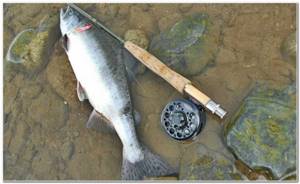
Spinner-spoon
Very often this spoon is used when fishing for perch and you can easily make it yourself. Below we will similarly explain how to make a lure for perch with your own hands:
- Take thin sheet metal, steel will do just fine, if not, then you can take an ordinary tin can from any drink. Cut a square sheet with metal scissors and straighten it, this will make it easier to draw the contours of the bait.
- Our bait will be in the shape of a diamond, use a permanent marker to mark the dimensions on the sheet.
- Using metal scissors, cut out the prepared layout.
- Calculate where the minor axis is located, along it you need to bend the metal gradually giving the shape of the bait.
- After giving the workpiece a shape, you need to solder a small triangle of copper, this can be done using a soldering iron.
- Then the hook is soldered to the copper plate.
- You will need to secure a ring at the top of the triangle; it is necessary for attaching the fishing line. To do this, drill a hole, it is advisable to wet the drilling site, otherwise you may damage the drill or part.
- Finally, we need to sand our vibrator and then it will be ready for use. Below you can see photos of do-it-yourself spinners.
Read here A nod for do-it-yourself winter fishing - how and what to make good gear from. 115 photos and video tips from the pros!
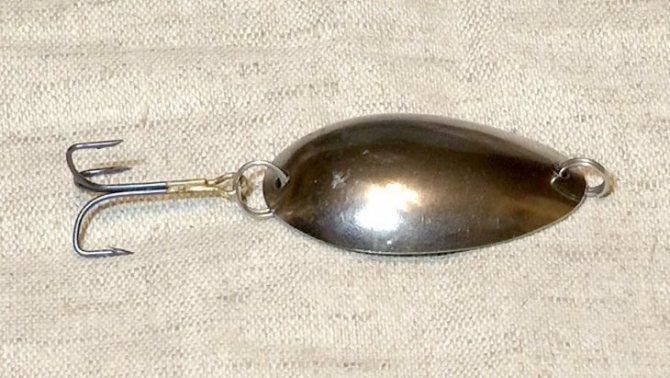
Useful tips
- Nelma is careful enough to leave the place next to which a fussy man is running along the shore. When fishing like this, you need to behave with restraint, do not go into the water unless absolutely necessary, and do not talk on the phone or with your partner too loudly.
- The bait should be cast quickly or at a medium pace. Such a movement will not go unnoticed by the nelma; if it is there, it will definitely bite.
- It is recommended to equip the spinning rod with bright braid, which will make it easier to control and manage the spinner. It definitely won’t scare the object of fishing, since the color of the cord is completely indifferent to the salmon.
- When playing, the fish makes powerful jerks to the sides and also jumps out of the water. Of course, such a fight brings a lot of pleasure, but it is advisable to remove the prey carefully, without unnecessary noise. Otherwise, other nelma will leave after receiving an alarm signal, and further fishing will be fruitless.

